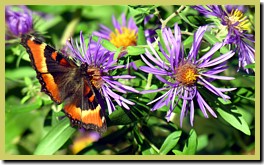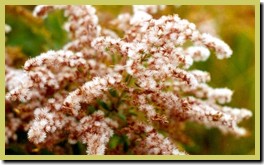
Asters! Manitoba's Fall Wildflowers
IntroductionSummer’s over. Gone is the heat, humidity and mosquitoes; replaced by the cool nights, brisk days and changing colours of autumn. And along with summer’s end, come some of my favourite wildflowers, the asters. I’m particularly fond of asters, as they are the harbingers of autumn, my favourite season. From mid-August until well into October there will be asters of some sort blooming in Manitoba. Biodiversity
|
||
Biology of AstersAsters take their name from both the Latin and Greek words for star. They are members of the Asteraceae, the family of plants also known as the “composites”. This is owing to the nature of their flowers. What appears to us to be a single flower is, in fact, a composite of many tiny whole flowers. Think of a tall spike of flowers that has been squished down into a flat disk, with each of the flowers within the disk having lost their petals and those on the outermost rim of the disk having just one petal each; that’s a composite flower.
Grow Your OwnNative asters can help keep your garden in bloom well into the fall. There are several local suppliers of native plants in Manitoba, and even some of the major nurseries now carry some native wildflowers, including asters. I hope you’ll resist the temptation to remove plants from the wild. Most plants don’t do very well when transplanted from the wild and you may end up introducing unwanted plants into your garden along with the clump of soil containing the plant you do want. |
||
|
||
Which aster to grow may be as important as how to grow them. Most native wildflowers will do well in garden settings, but some do too well! What was in the wild a small delicate plant, may end up being a monster in the garden. Smooth Aster is a case in point. This is probably the most common aster species in southern Manitoba; it readily invades disturbed sites and roadside ditches. In the wild it may grow to half a metre high and sport a couple of dozen bright blue flowers. Unleashed into a garden it may grow to a metre in height AND width, and be covered in hundreds of flowers. Now, it can be very attractive as such in a garden, but it may end up sprawling over and crowding out much of the rest of your garden, too. My favourite for the garden is New England Aster. It has an upright growth form; it won’t sprawl around, and it produces lots of large, purply-blue flowers starting in mid-August and lasting well into September.
In ClosingSo, for late season colour in your garden, and to give our bees and butterflies a boost to help them through winter, or on their way to warmer climes, try some of our native asters in your garden.
More aster articles in NatureNorth: Asters - Fall Wildflowers | Star Flower - a New Age Tale |
| You can help NatureNorth produce more great articles with a secure donation through PayPal. Our Google Adsense ads pay our server costs, but that's about it. To learn more follow this link: Support NatureNorth. Thank-you! | |



